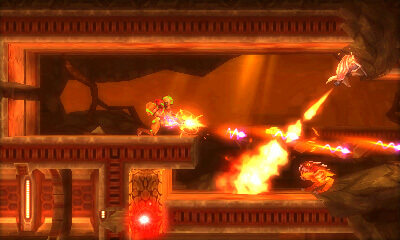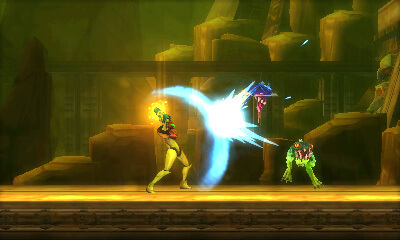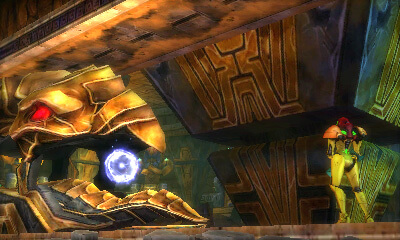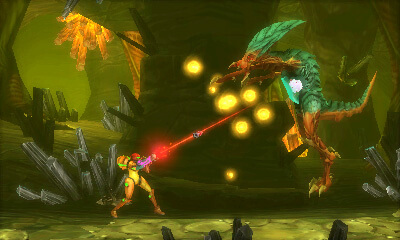Looking back through the Metroid series, there is one game that stands out as the worst Metroid game in the series. No, not Other M, although a strong case could be made against it.
Metroid 2: Return of Samus is an odd duck in the franchise; it maintains the gated progression that Metroid games are known for while failing at the environmental story-telling that has become inherent in the series. The biggest complaint about Metroid 2, however, is that the game was stranded on the GameBoy. With that said, Metroid: Samus Returns by Mercury Steam looks to solve the issues that Metroid 2 had, while expanding on a game that a majority of Metroid fans have never played. Hit the jump to read on!
The Galactic Federation has tasked Samus Aran, the greatest bounty hunter in the galaxy, with a simple task: eradicate the organisms known as metroids on their home planet of SR388. After the relatively brief opening cut-scene, players are given control of Samus as she traverses through the labyrinthine caverns of SR388. Speaking of cut-scenes, the game rarely makes you relinquish control of Samus, but when it does it’s to either guide you towards your next objective, highlight important utilities, or just to show off awesome Samus really is.
Playing Samus Returns is a typical Metoridvania affair: you’re put in an open environment with areas that are out of reach until you find an upgrade that’ll let you access those previously unreachable areas. Samus Returns features a handful of returning favorites like the screw attack, ice beam, and space jump, and new abilities and upgrades as well. Most notably, and prevalent, are the melee counter and the aeion upgrades.
The melee counter is a brand new skill to the series and is implemented during almost every encounter with enemies in the game. This is both a benefit and a detriment to the core game play loop. You can either stand and wait for an enemy to attack you so you can counter it and deal a devastating blow, or just keep your distance and shoot down any enemy before it gets near you. Focusing entirely on one play style can make the game feel repetitive so it’s up to you as the player to mix up your approach to enemy encounters. If you see a flying enemy about to swoop down at you, why not try hitting it with your ice beam and shatter it with a missile? That crawling creature is making it’s way towards you? Leave a morph ball bomb in its path! Although, to be fair, the melee counter is clearly the better and more efficient way of dispatching enemies and the game feels like it was designed around that fact.
As you travel through SR388, you’ll be tasked with eliminating every hostile metroid in every sector. When you enter a new sector you’ll pass through rooms that have giant structures that will indicate how many metroids are present in that sector. In these rooms, the path to the next sector is always blocked off by a mysterious purple liquid that eats away at Samus’ health when touched. In order to drain this liquid, you have to offer up the DNA of the metroids that you defeat.
Unfortunately, fighting metroids might be one of the aspects of the game that gets old really fast, especially considering there’s aorund 40 metroids in total to be defeated. The metroids themselves go through various stages of evolution the further you are in the game, but not nearly enough to keep every fight feeling fresh. At a certain point it just feels a bit stale. Luckily though, there are four other boss fights that bring a welcome change of pace.
SR388 is a planet that has never really been explored that much in the Metroid games, outside of Metroid 2 and briefly in Metroid Fusion. Granted, in Fusion we do learn about the different types of environments present on SR388. With Samus Returns we finally get to see the planet fully realized; from it’s caverns filled with the ruins of the ancient Chozo race to the weirdly tropical area that’s somehow not on the surface of the planet.
The Chozo were a race of highly intelligent beings that made advances in science and technology so complex, the rest of the galaxy has yet to even match a majority of what they accomplished. As the Chozo colonized SR388, they discovered a particularly nasty parasite that would infect a host creature, killing it from the inside out and mimicking the host. To combat this parasite, the Chozo created the Metroids, the titular life draining creatures that eventually took over the planet after the Chozo abandoned it. Interestingly enough, the Chozo were also the beings that eventually adopted a little orphan girl by the name of Samus Aran, trained her, infused her with Chozo DNA, and eventually presented her with her now iconic Power Suit.
Metroid: Samus Returns feels exactly like the name implies, it’s the return to the Metroid series that fans have been wanting for a very long time. It’s not a perfect game by any means, but it is definitely a step in the right direction. As it stands, there isn’t really a need to remake any other Metroid games, although the ending to Samus Returns does hint at it. If there are more remakes of other Metroid games on the way, I’m all for it. But I think it’s time we got a totally new entry into the series. Here’s to hoping Metroid Prime 4 can live up to the legacy of the Prime trilogy. But for now, let’s just bask in the joy that our girl Samus is back.
Metroid: Samus Returns is out now on Nintendo 3DS and 2DS.



